From the West Hartford Archives: Longue Vue Farm, New Britain Avenue

Audio By Carbonatix
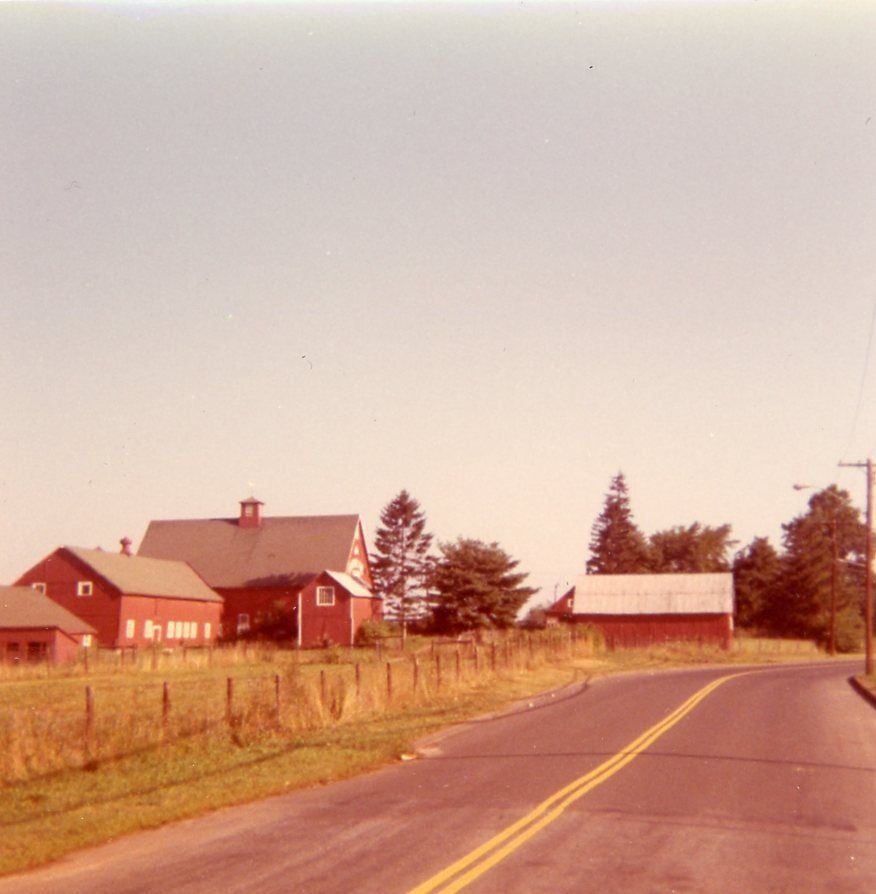
Longue Vue Farm. Photo courtesy of Noah Webster House & West Hartford Historical Society. Photo by David Allen
Historian Jeff Murray takes a look into West Hartford’s past to uncover some surprising information, stir up some memories, or reflect on how much life has changed – or hasn’t changed at all. Enjoy this week’s ‘From West Hartford’s Archives’ …
By Jeff Murray
This photograph was taken in 1956 by David Allen and shows the Longue Vue Farm along Chatfield Drive on the curve north to New Britain Avenue. Owned by Ralph and Maude Gerth, this farm had an extensive history that spans over 60 years. It begins with Maude Gerth’s grandfather, John McCartney, who was born in Ireland in 1834 and immigrated to the U.S. in 1854.
After the outbreak of the Civil War, McCartney served with the 5th Connecticut for three years. Upon his return, he worked as a wood dealer and moved in the 1870s from Rockville to New Britain, where he owned his own wood yard. His wife, Rachel, who had emigrated from Scotland, had three children – Mary (who died young), Annette, and William.
Annette was born on April 9, 1860 and married Edwin Chatfield in 1885. They had one daughter, Maude Olivia Chatfield, when they lived in New Britain. Edwin died when Maude was 4 and the two lived with her McCartney grandparents by the turn of the century. Annette bought a storefront in downtown New Britain along Main Street and opened up Chatfield News Store, a newspaper and stationery business. When her brother William, more than 10 years younger than her, came of age, he joined her in the newspaper store as a salesman.
Around 1901, Annette and William bought a 50-acre farm on the south side of New Britain Avenue, east of Corbin’s Corner, now the site of Brookdale Chatfield senior living. They used the farm to house their three horses that their employees rode to deliver Sunday newspapers.
Still living in New Britain, over time they began to be more connected to the farm. In 1906, they advocated for the extension of the trolley line from South Quaker Lane west through Corbin’s Corner (although that never happened). Her brother William built a brick house at 1383 New Britain Avenue for his father, who moved in after his mother died. By 1910, this house was occupied by John, his 25-year-old niece Maude Chatfield, and two Irish farm laborers. Soon after, they bought up an additional 29 acres on the north side of New Britain Avenue on both sides of Ridgewood Road.
On Aug. 11, 1913, Annette’s daughter Maude married Ralph E. Gerth, who was the manager of the Waterbury exchange of the Southern New England Telephone Company. They had their first children in the house at 1383 New Britain Avenue and after her grandfather, John McCartney, died in 1915, the Gerths were the only occupants. Her uncle and mother therefore sold the entire farm to them at the beginning of 1916, marking the beginning of the modern farm seen here.
With the purchase, Ralph requested a move from the Waterbury exchange to the New Britain one to be closer. In the meantime, the couple managed the land here and raised their four children. In 1922, the Gerths bought the adjoining farm to the east, the former Francis farm across the street from Berkshire Road. Roger Francis had been born in the homestead on this adjacent property in the 1830s, also served in the Civil War, and had sold off the land a decade prior to retire to Springfield after his wife had died. This purchase in the spring of 1922 doubled the land that the Gerths owned and allowed them to move into the older Francis house at 1365 New Britain Avenue, rent out the brick house to the west, sell off the extra equipment, and open what they called Longue Vue Farm.
Their primary product at the time was golden Guernsey milk, developed and bred from purebred Guernseys on the direction of Maude. This milk was sold to markets in West Hartford and beyond for many years.
After a disastrous fire on April 5, 1925 destroyed nearly all of the buildings on the farm, they were forced to rebuild. Ralph laid out 15 acres of orchard land – apple, cherry, pear, and peach trees. His management of the land pushed him away from the telephone company and he went into real estate and auctioneering. By 1926, he was one of the leading auctioneers in the country, selling significant property on behalf of the U.S. shipping board and war department.
According to one account, he sold 216 building lots in a little over four hours in New Jersey. A year later, he bought 87 acres from the Beach family along South Main Street in a tract called Sunny Ridge. English-style houses were built along the west side of the road south of New Britain Avenue, which laid the groundwork for the development of Knollwood Road and Davenport Road in coming decades.
The land at one time was proposed for the location of a municipal airport and Charles Lindbergh had chosen Longue Vue Farm for one of the stops on his cross-country tours before the Gerths canceled on the contract to avoid the tourists. Not long after, the Gerths bought an additional 300 acres (that is not a typo!) on the east side of South Main Street in the same area. Included in the purchase was the famous Sarah Whitman Hooker house.
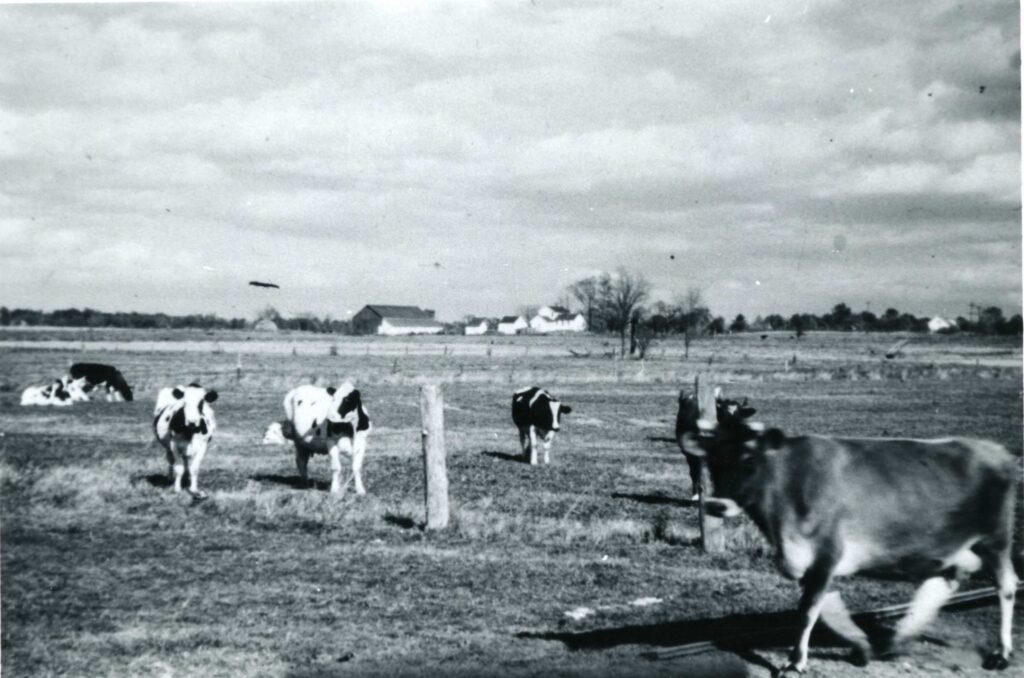
Cows on the Gerth farm, looking north. Photo courtesy of Noah Webster House & West Hartford Historical Society
Maude, vice-regent of the Sarah Whitman Hooker chapter of the Daughters of the American Revolution, made it her mission to restore the house. In 1929, a bronze memorial tablet was placed on the property to dedicate Maude’s work, which helped to “perpetuate the memory, the acquisition, and protection of historical spots.”
Maude was prominent in community affairs – she hosted husking bees and barn dances, D.A.R. meetings and picnics, country fairs, and old-time musicals on Longue Vue. She pushed to preserve the building of the Noah Webster Library and keep the name. She organized the West Hartford Council of the PTA, sponsored a night school program for foreigners at Hall High School, and chaired the National Red Cross local chapter.
She imparted this patriotic spirit onto her children, who were leaders in the local chapter of the Children of the American Revolution, of which her son Ralph Jr. was president. His two sisters Patia Mae and Ruth represented the organization on the national level, presenting flowers directly to the First Lady Grace Coolidge in 1927. Their brother Charles joined the others in Washington’s birthday commemorations in full colonial costumes.
As the elder Gerths got older and the children came of age, the family looked to expand their operations, if only in variety. In 1936, Ralph bought the Shuttle Meadow Riding Academy at the northwest corner of Ridgewood Road across from Corbin’s Corner and reopened the expansive stables under the name Longue Vue Stables. As an avid horseman, he helped organize the New England Breeders and Racing Association. His daughter Ruth helped design the interior of the lounging room and clubhouse to give it a “feminine touch.”
The stables quickly became popular, with cars lining the road to Corbin’s Corner and riders heading out towards Batterson Park. Maude opened a kennel near the rotary the following year. On the family farm, they built a small log cabin for use by the children, using beams taken from the barn of the Sarah Whitman Hooker house and fireplace stones from the ruins of a Revolutionary War campsite on Talcott Mountain. In 1953, Station WKNB-TV, Hartford County’s first television station, bought the corner from the Gerths and built its radio and television studio at Ridgewood Road. Nothing much has changed there since.
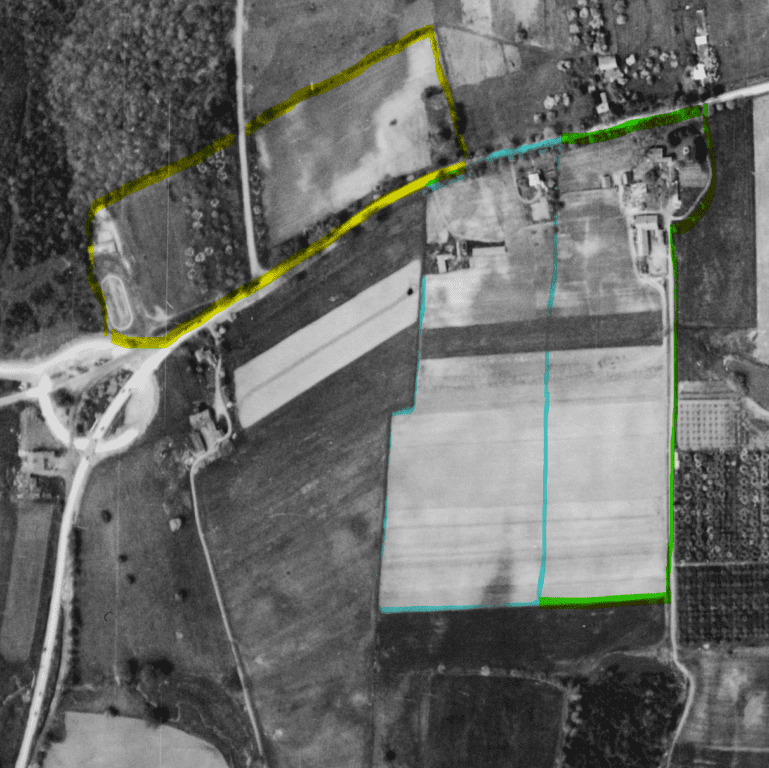
An aerial look at the Gerth holdings near Corbin’s Corner in 1934 – their future stables and riding club are in yellow; the original farm is in blue; and the newer acquisition in 1922 in green. Note the farm road at right follows the same path as the current Chatfield Drive and Regency Drive
By the end of World War II, the Gerths were in their 60s and times were changing. Patia Mae and Ruth married. Charles came back from the war after service as an aviation radioman and a former member of the Connecticut Governor’s Foot Guard. Tragically, he died at the age of 29 in 1951 from complications of a brain tumor. His brother, Ralph Jr., who had followed in his father’s footsteps in horseracing, had taken over as director of the farm, but he also died young – just a year after Charles in 1952.
Within the next five years, Ralph and Maude turned to their next venture and it was much needed to accommodate the baby boom – housing. Plans were made in 1955 to carve out housing lots from Longue Vue Farm. The Suburban Development Corporation outlined the path of 200 houses on the south side of New Britain Avenue from a road that ran along the old farm lane. It was known as Chatfield Drive, named after Maude’s family. Families with children moving into Longue Vue Acres would be accommodated by the Elmwood and Webster Hill Schools, but that wasn’t enough and Wolcott School was partly a response to this growth of housing in the southwest end of town.
The streets behind the farm were a product – originally Gerthmere Drive, Burnham Drive (named for builder Robert L. Burnham), Regency Drive, the extension of Elmfield Street, and Red Top Drive. More than 75 homes were built in two years, sold for an average of $17,000 each and with no down payment for veterans. Skating was allowed at the so-called Gerth Pond starting in 1958.
All good things must come to an end though and Longue Vue Farm was no exception. The interstate highway system, initiated under the Eisenhower administration, had a profound impact on development. The highways opened up vast regions for suburban construction, but farmland was often seized through eminent domain for use by the highway. On Aug. 11, 1963, on their 50th wedding anniversary, Longue Vue Farm was condemned by the state. This included the northeast corner of Ridgewood Road, which today is the entrance and exit from I-84 at Corbin’s Corner.
Taking a walk through the farm, Ralph and Maude could remember the origin of every single tree and mark on the land. Most of the farm was torn down, leaving only a few old barns and sheds. They moved into the Sarah Whitman Hooker house just down the road. Maude was quoted as saying, “If I were young … I’d take those handhewn logs and wooden pegs that form my barns, and I’d take them way out to the wilderness and reconstruct Longue Vue Farm.” Ralph died in 1969, followed by Maude in 1970.
On Aug. 10, 1972, a two-alarm fire destroyed the remaining two barns and three sheds at Chatfield Drive and New Britain Avenue. A month before, the construction of Wolcott Park had just started on land donated by the Wolcotts. The Gerth property was put on the market soon after. Proposals were made in 1974 and 1975 for an office park, but the Town Council rejected them.
In the spring of 1981, a partnership looked to buy the property and build condos. After some confusion by the Town Plan and Zoning Commission, who apparently thought that they owned the land (they did not) and years of opposition, the Gerth estate sold the land to Colonial Gerth Limited Partnership for $1.1 million and One Chatfield Drive opened in 1989 as a rental retirement community.
I wonder what memories Maude could have shared on all the things she saw when she moved to the farm in her 20s to live with her grandfather. She would have known the area where Wolcott Park is now even before it was in the Wolcott family. The Corbins actually lived at Corbin’s Corner. The area across the street, where Conard High School would be built a half century later, was just swampland. By the time she died, Sears and the surrounding plaza at the corner were celebrating nearly a decade.
Much has changed along New Britain Avenue in the last 50 years. What comes next?
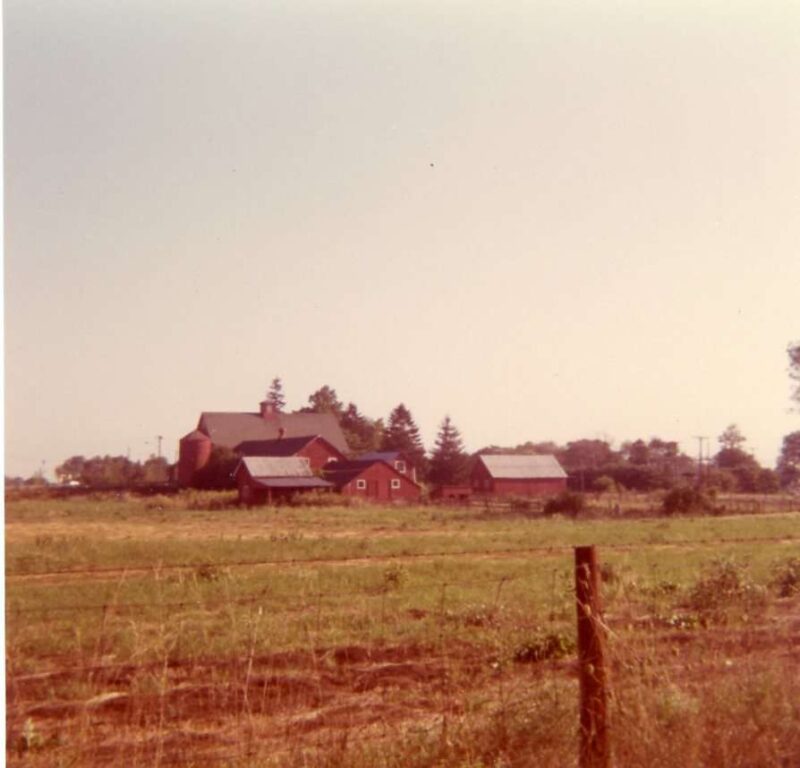
A view of the farm from a distance, looking northeast towards Chatfield Drive in 1956. Photo courtesy of Noah Webster House & West Hartford Historical Society. Photographer: David Allen
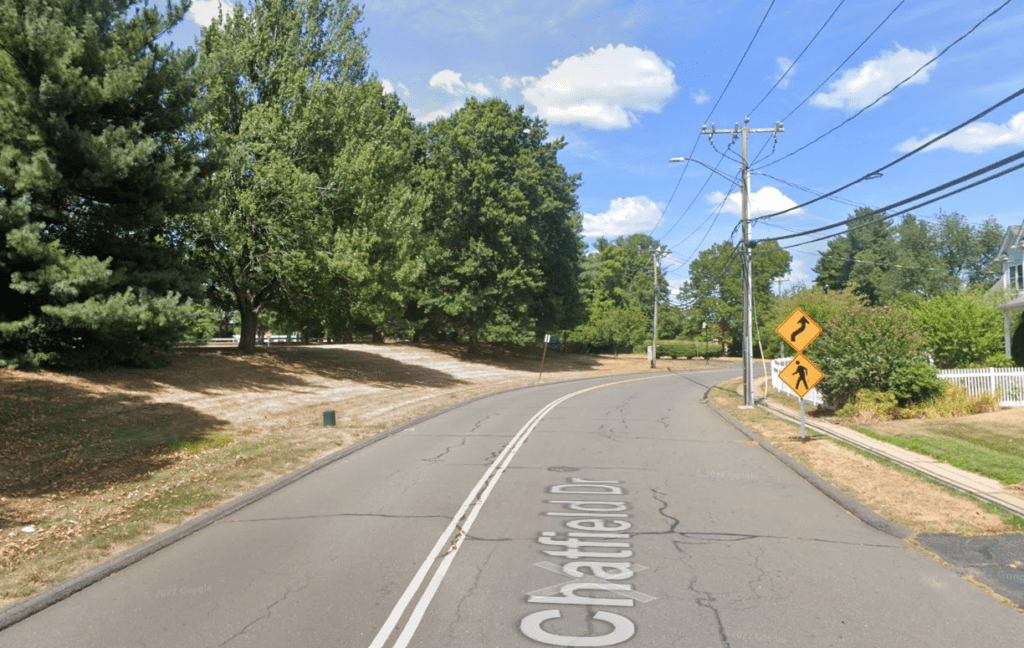
Chatfield Drive. Google Street view
Jeff Murray was born and raised in West Hartford and has been involved with the Noah Webster House & West Hartford Historical Society since 2011 when he was a high school student and won the Meyer Prize for his essay on local history. Jeff routinely volunteers as local history researcher uncovering information for numerous museum programs such as the West Hartford House Tour and West Hartford Hauntings. Jeff works as a data analyst at Pratt & Whitney.
Like what you see here? Click here to subscribe to We-Ha’s newsletter so you’ll always be in the know about what’s happening in West Hartford! Click the blue button below to become a supporter of We-Ha.com and our efforts to continue producing quality journalism.


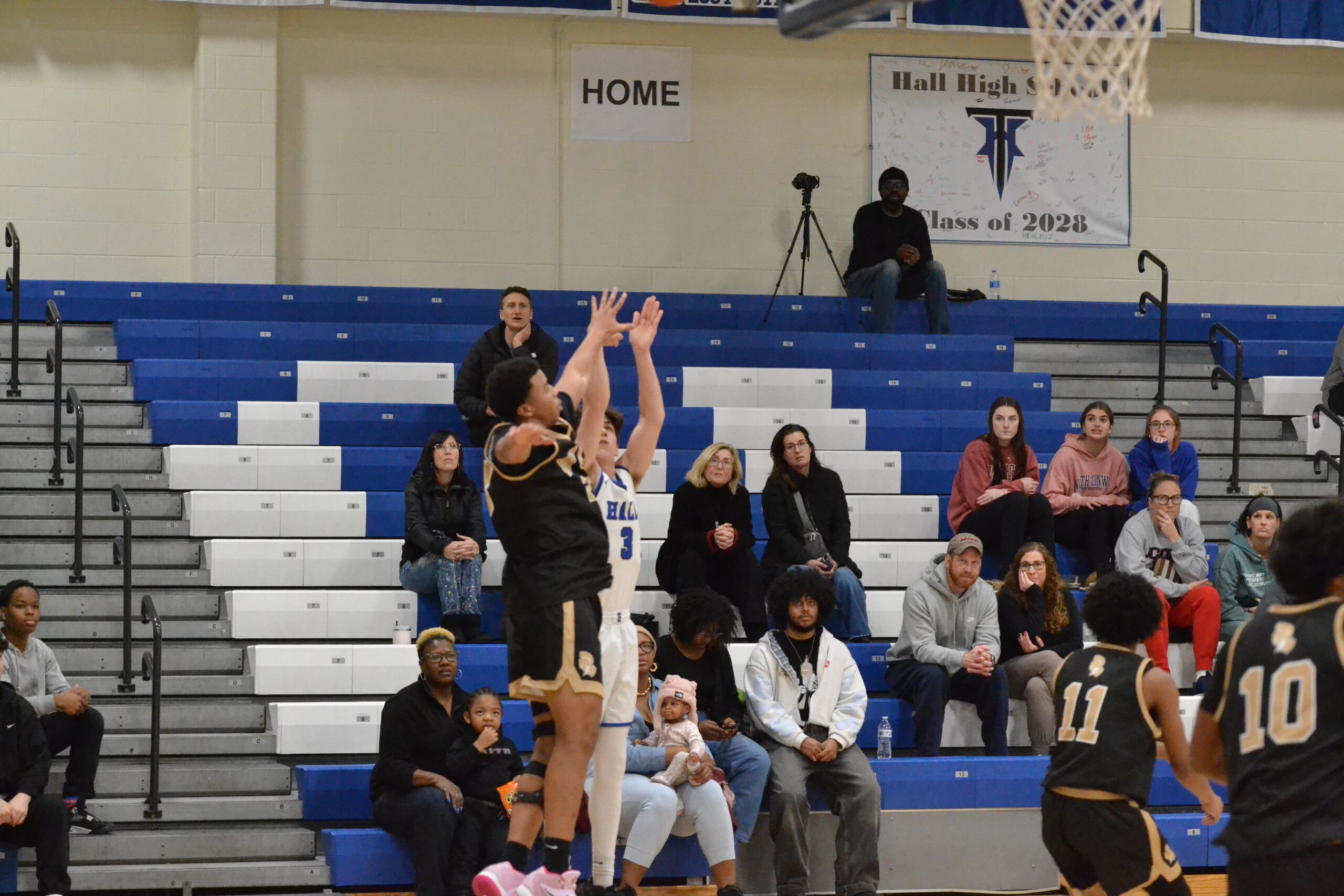
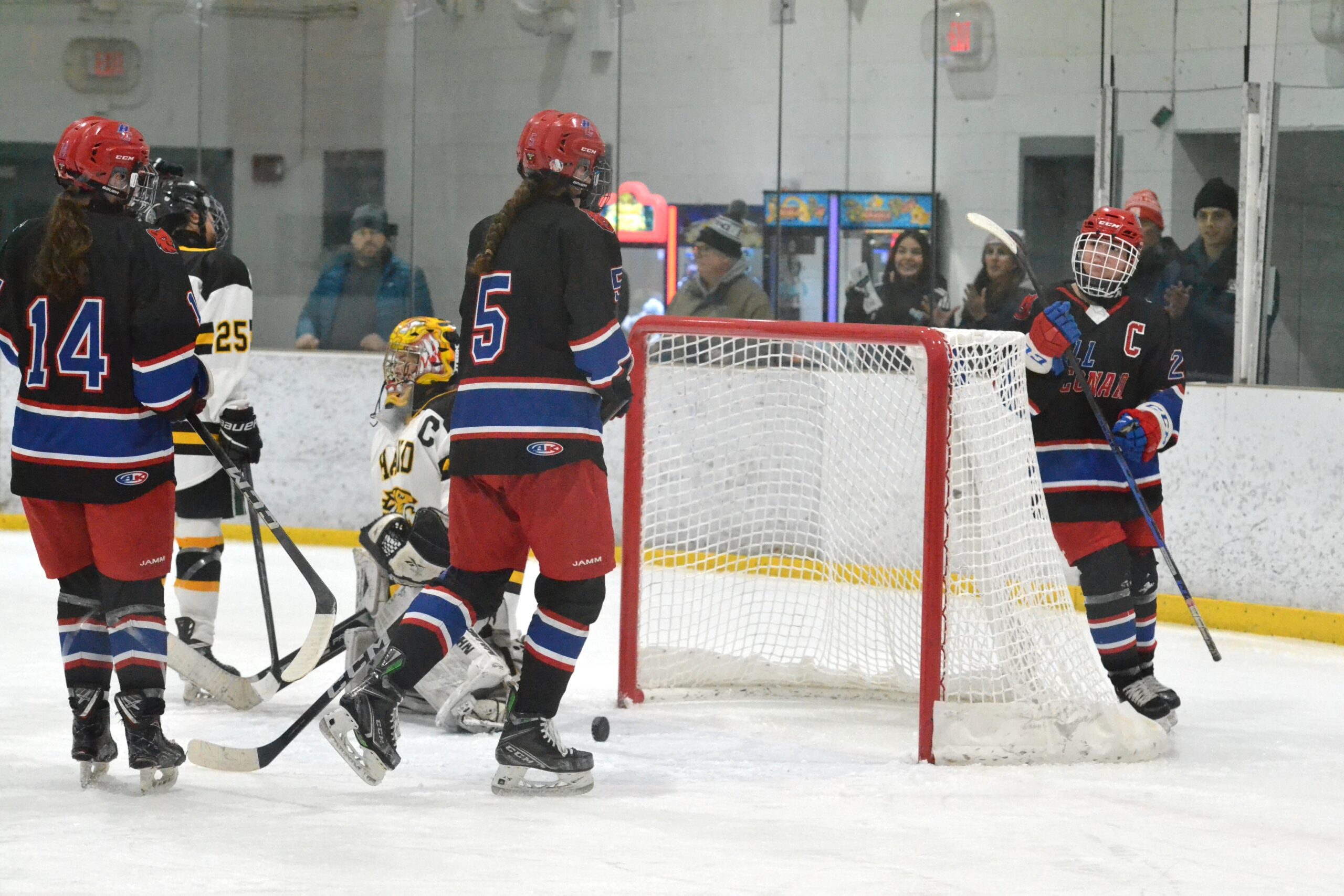
I grew up up in that neighborhood {Huckleberry Lane} in the 60s and 70s. All the kids in the neighborhood played in and around that whole area when the barns were still there skated on gerth pond and walcott pond and watched the construction of the park. Lots of memories riding my dirt bike on the farm as we got a little older. I live in Kentucky now and its been a few years since ive been back to neighborhood I know a lot has changed even in just a few years.
I grew up on Fowler drive and spent time at that farm petting the horses. One of my teachers model T burned in that fire in August of 72. Thanks for sharing the history.